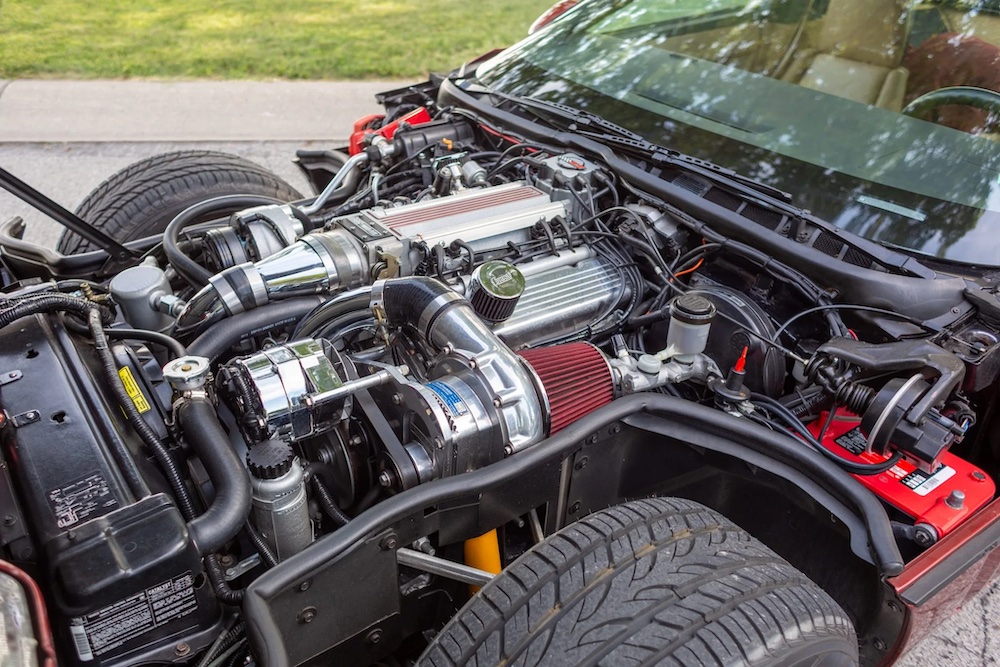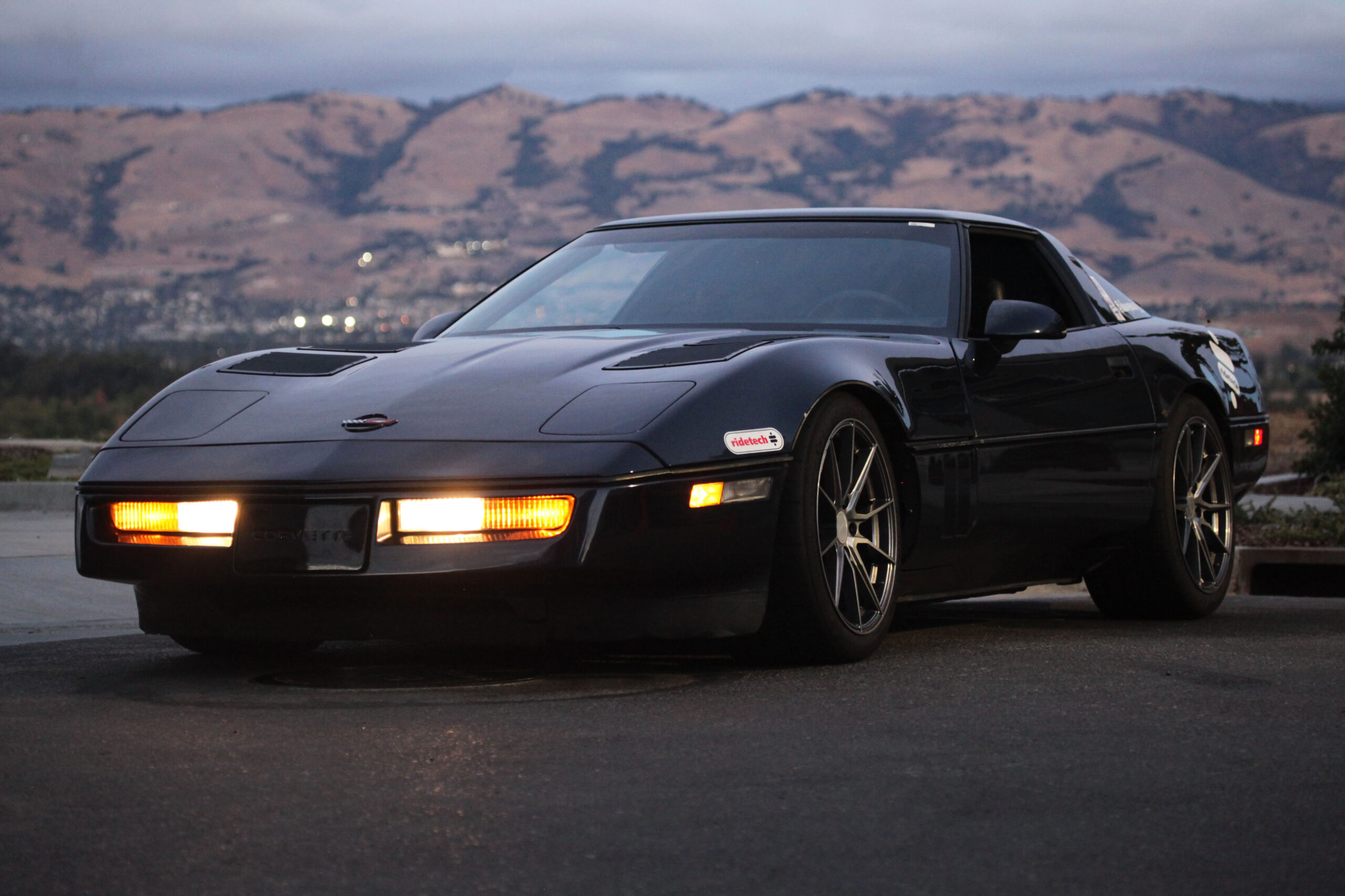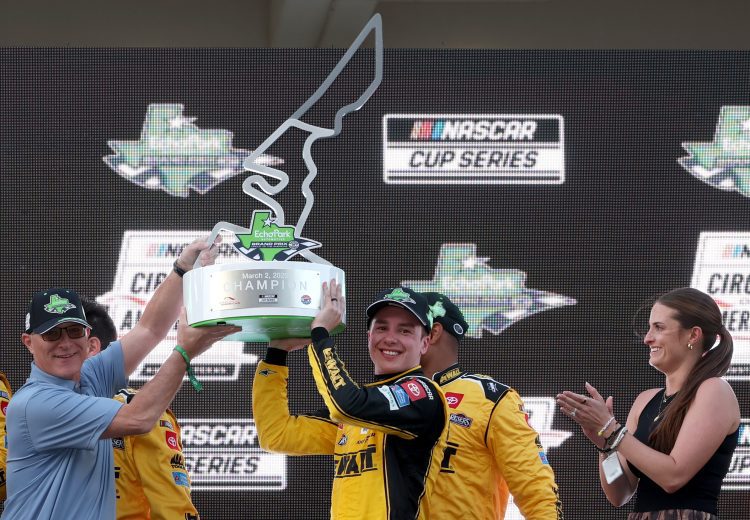1984-1996 C4 Corvette Buying Guide

Introduction to the C4 Corvette and the C3 Legacy
In 1982, the final third generation Corvette would leave the assembly line making way for an all-new version in 1983, but that never happened. Instead, the fourth generation wouldn’t be ready until the 1984 model year. Today, the C4 Corvette represents a great sports car value for both street and track driving. While falling somewhere in between the timeless styling of the C3 and the modern performance of the C5, this generation introduced owners to modern electronic fuel injection mated with stiff, race car inspired suspension systems. Once you get over the car’s quirks like climbing over the wider than necessary door sills to enter the car, you’ll find a firm but pleasant driving experience that rivals any other of the day.
See all DigiRides Member C4 Corvettes
1984 Model Year
The ’84 model year Corvettes feature the same L83 Cross-Fire Induction 350ci V8 that was used in the previous generation. That will give you 205hp and 290 ft-lb of torque with either a Doug Nash 4+3 manual or 700-R4 automatic transmission. Many cars were outfitted with the Z51 suspension which was known to be extremely stiff and uncomfortable and comes with 16×8.5” front and 16×9.5” rear wheels standard. These cars are extremely plentiful with GM producing 51,547 units which was the second highest production ever for the Corvette line.
As with the first year of most newly produced models, this is probably the least desirable of the C4 generation. It has the fewest features and lowest power output. Many people remove the Cross-Fire Induction and simply go with a carburetor for ease of tuning and maintenance. The high point for this year is that they are abundant and can be found very cheaply.

1985 Model Year
Things got better a year later when the ’85 debuted the L98 Tuned Port Induction (TPI) 350ci V8 that makes 25 horsepower and 40 ft-lbs of torque more than its predecessor. The Z51 suspension package was reworked to be less stiff and squared up the wheels with 16×9.5” at all four corners. Other rear gearing options were available to give you a little more jump off the line.
Outside of price and availability, there really isn’t any other reason to choose the ’84 over the ’85 as it’s a much better car.

1986 Model Year
The first convertible C4 was introduced in ’86 along with two special edition cars: Malcolm Konner Commemorative Edition and the Indy 500 Pace Car. Other changes included the addition of a center brake light, anti-lock brakes (standard) and the Vehicle Anti-Theft System (VATS). Horsepower received a slight bump (+5) to 230hp with the move to aluminum cylinder heads.
The special editions featured limited production numbers and special paint or graphics, but haven’t proven to be overly desirable over the years. The ’86 is a very modest improvement over the ’85.

1987 Model Year
Things got more interesting in ’87 when Car and Driver named the C4 Corvette to its coveted Top 10 list. Horsepower increased to 240hp and the Z52 sport handling package made its appearance. Both the Z51 and Z52 packages came standard with 17×9.5” wheels at all four corners. The big news was the introduction of the RPO B2K Callaway option (+$19,995) which provided the C4 with 345hp (+105) and 465ft-lb of torque (+235) from a twin-turbocharged L98 V8. There were 188 produced (123 coupes and 65 convertibles) for the model year which also provided hood mounted NACA ducts, a boost gauge and serial plaque.
Outside of the Callaway option, the ’87 was left relatively unchanged from the ’86.

1988 Model Year
In ’88, GM produced a 35th Anniversary Edition which was limited in production to 2,050 units and features an all-white appearance: paint, moldings, wheels and full interior. The base car received some minor interior improvements along with dual-piston front calipers and reworked suspension parts.
The interior of the ’88 is just a little nicer than previous models. Some aftermarket suspension and brake systems only work on the ’88 or newer cars, so this might be worth paying a little more for if you plan on doing modifications.

1989 Model Year
The ’89 dropped the Doug Nash 4+3 in favor of the much-improved ZF-6 (Zehnradfabrik Friedrichshafen) six speed transmission with CAGS (computer aided gear selection). In addition, 17×9.5” wheel became standard on all cars and the FX3 selective ride and handling system made its debut.
The ’89 with a manual transmission might be the very best buy in the C4 world. By now, many of the issues with the original design had been fixed or improved upon.

1990 Model Year
In ’90, all models received a completely updated interior that replaced the digital dash with hypred analog gauges. The big news for the year surrounded the release of the ZR-1 “King of the Hill” Corvette which was powered by an all new 32v, dual-overhead cam LT-5 engine that was developed with Mercury Marine and made 375hp. The ZR-1 sold 3,049 units and also received a wider rear and updated facia.
The ’90 equipped with the FZ-6 is another great buy like the ’89 but features the updated interior which seems to have better stood the test of time.

1991 Model Year
An updated exterior design rolled out for all models in ’91. This included new front and rear facias along with wider body moldings and new parking/signal lights. While the ZR-1 option would continue to be available, 1991 marked the end of production for the L98 TPI engine and B2K Callaway option.
This is the only year where you can receive the newer style body with the TPI V8 and marked the very best of the platform that had been around for seven years.

1992 Model Year
The base model Corvette would now be powered by an all new 5.7L, 350ci LT1 engine making 300hp and 330ft-lb of torque. You could now have traction control included with the ASR system. In 1992, the one millionth Corvette rolled off the assembly line, but that special car was later destroyed when a sink hole opened up in the National Corvette Museum where it was being displayed.
The bump in performance from the LT1 engine is noticeable and well worth paying a little extra for.

1993 Model Year
Marking another milestone for Corvette, the ’93 model year provided the 40th Anniversary edition package which included a special Ruby Red Metallic exterior with Ruby Red leather interior along with special badging. This was also the first year to include a proximity key-fob transmitter keyless entry system.
Overall, there isn’t any real reason to choose a ’93 over a ’92 model year because there were so few changes.

1994 Model Year
Minor improvements took place in ’94 including the change to sequential fuel injection to provide improved idle and drivability while the standard four-speed automatic received electronic shift control for better performance.
These slight changes do provide a better driving experience making it a worthwhile upgrade over previous years.

1995 Model Year
With C5 design and testing well underway within GM, the ’95 received only minor improvements including some internal engine components and the use of the ZR-1’s heavy duty brakes across all models. A special model was commissioned to commemorate the use of a Corvette to pace the Indy 500. The pace car replica was a limited production convertible with special paint and graphics. This would be the final year of production for the ZR-1.
With only slight improvements, there isn’t much of a compelling reason to choose this this year over others.

1996 Model Year
The ’96 model years would mark the end of the 4th generation Corvette and the Gen II small block engine. A special edition of the LT1 engine would be available denoted as the LT4 and featured 330hp backed only by a six-speed manual transmission. This could be ordered in either of the year’s two special editions.
The Collector’s Edition features a silver exterior and special badging honoring the end of the generation. The Grand Sport features a blue exterior with a single white stripe up the middle of the car and red fender hash marks honoring the Grand Sport of the 1960’s. Both cars were available as a coupe or convertible, but only the Grand Sport could be ordered with the bright red interior design.
As the final cars build for the fourth generation, these are the most refined and well built.

Support (manufacturer / aftermarket)
Many OEM parts are still being produced by GM while the aftermarket offers just about anything else you could need. Don’t want to pay top dollar for new parts? Well, you’re in luck because there are junk yards full of C4 Corvettes with parts from all model years available.
Unfortunately, there aren’t a ton of aftermarket performance options like there are for C5 and newer Corvettes. There are just a couple of supercharger kits available and no complete turbo kits. High flow intakes and other such parts are no longer in production, but can be found online in forum marketplaces from time to time.
Reasons to Buy:
The C4 Corvette offers an amazing sports car experience significantly cheaper than options from other manufacturers. Where else can you get 200+ horsepower and 300+ ft-lb of torque out of a V8 for less than $10,000? On top of that, they have an excellent reputation for being relatively reliable without being overly costly to repair. You aren’t getting that from Ferrari, Aston Martin, Audi or BMW cars of the same era.
Reasons to Avoid:
If you plan to own a C4, make sure you have other rides or forms of transportation because it is certainly not the best daily driver. They are hard to get in and out of and have very little cargo space; especially the convertibles. They are extremely low to the ground and don’t have any of the modern convenience and safety features that you will probably want in a daily driver. Owners of cars with the LT1 engine should be prepared to do an Optispark distributer replacement every year or two which will cost over $1,000 in most parts of the country.
Values
What does the future hold for the C4 Corvette in terms of value you might be asking? It appears as though they have about bottomed out and have already begun to appreciate in some circumstances. Keep in mind, this doesn’t mean that all C4s will increase in value. This will be reserved for low production, high performance and special editions like the Grand Sport, Callaways, ZR-1s and even base models with low mileage or tasteful modifications. A standard, high mile car with peeling clear coat and faded interior will never appreciate without a full restauration.
One of the best bargains to be found are the ’89 or ’90 cars with the ZF-6 manual transmission which is significantly better than the 4+3 it replaced. These cars are still available for a decent price and will not disappoint. The ’90 will have the updated interior over the ’89 and both will have the L98 TPI at it peak spec prior to the rollout of the LT1.
But who cares? The C4 is a great sports car that offers driving excitement at an amazing price point. Parts are mostly plentiful and there is a huge community of enthusiasts to guide you in your journey of ownership. Cars aren’t supposed to be considered investments anyway, so buy one and enjoy the ride.

Final Word
The C4 Corvette represents a great sports car platform to drive and enjoy. It is abundantly available with models to fit just about anyone’s budget. Offerings from other manufacturers of the era are generally more expensive to buy and own while providing less performance. With a perceived market bottom finally setting in, this might be the very best time to get behind the wheel of a fourth generator Corvette.






